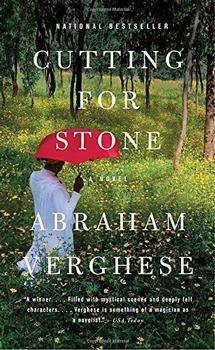Summary | Excerpt | Reading Guide | Reviews | Beyond the Book | Read-Alikes | Genres & Themes | Author Bio

This article relates to Cutting For Stone
The title, Cutting for Stone, refers to a line in the Hippocratic Oath,
and to the last name of the three main characters, all of them surgeons. As
Abraham Verghese quotes it, the line from the Oath reads "I will not cut for
stone, even for patients in whom the disease is manifest. I will leave this
operation to be performed by practitioners, specialists in this art." While this
line refers specifically to surgery for bladder stones (which were quite
prevalent in the 4th century BC), it's also a directive against surgery of all
kinds. Ancient Greek physicians did not practice surgery, instead referring
their patients to trained surgeons. Surgery was then considered a secondary
skill, and surgeons were not trained in theoretical medicine as physicians were.
Dissection was forbidden, and without precautions against contamination or the
ability to anaesthetize, surgery was almost always deadly and certainly
unbearably painful.
It's believed that The Hippocratic Oath was written in the 4th century BC,
influenced by the doctrines of Pythagorean philosophy. It probably has several
authors, one of which may or may not be Hippocrates. Considered the father of
modern medicine, Hippocrates is credited with separating medicine from magic,
religion and superstition, and planting it firmly in a systematic and rational
school of thought. His thoughts and writings still form the basis of modern
medicine's ethical tenets, and continue to be adapted and debated as science and
medicine progress.
First do no harm is probably the most famous tenet most often quoted from
The Hippocratic Oath - but erroneously so. The phrase doesn't appear in any of
the many translations or adaptations of the Oath, and is likely adapted from a
phrase in Hippocrates'
Epidemics, though its exact origins are often debated.
Medical schools around the world recite oaths upon graduation, most of them
based on The Hippocratic Oath. Over time, schools have adapted and modernized
the oath, but the idea remains the same: to bind physicians to the art and moral
responsibilities of their practice and their patients, and to affirm a
commitment that the care of their patients is their first consideration.
Abraham Verghese is a surgeon, and Professor for the Theory and
Practice of Medicine at Stanford, and every year he joins his graduates as they
stand and take the oath. In an interview he remarks, "When the new graduates
take stand and take the oath, all the physicians in the room are invited to rise
and retake the oath. You see many physician parents and physician siblings
standing as their son or daughter or brother or sister takes the oath. It chokes
me up every time. Not only am I renewing my faith, but I am bursting with pride
in seeing my students graduate."
Filed under Medicine, Science and Tech
![]() This "beyond the book article" relates to Cutting For Stone. It originally ran in February 2009 and has been updated for the
January 2010 paperback edition.
Go to magazine.
This "beyond the book article" relates to Cutting For Stone. It originally ran in February 2009 and has been updated for the
January 2010 paperback edition.
Go to magazine.
Your guide toexceptional books
BookBrowse seeks out and recommends the best in contemporary fiction and nonfiction—books that not only engage and entertain but also deepen our understanding of ourselves and the world around us.